Skylark (Alauda arvensis)
(1) Where, when and how many
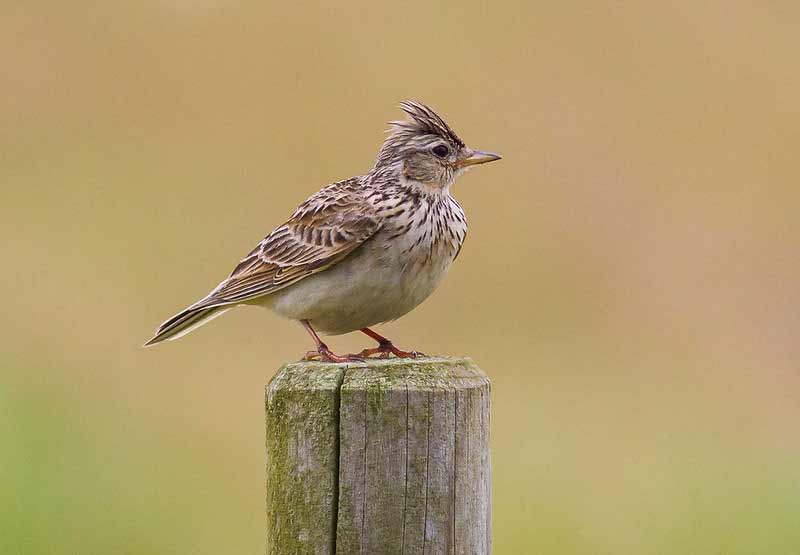
(© Natural England / CC BY-NC-ND 2.0)
When: On the Crown Lands, they are typically present from late winter or early spring through to early / mid-autumn - very few remain on the Forest in November, December and January. Elsewhere - on the coast and along the farmland edges - they are present for much of the year but are likely to move away in periods of very hard winter weather.
How many: Skylarks remain relatively widespread as a breeding bird on the Crown Lands, and frequently as a year-round presence on the coastal and farmland margins of the National Park.
(2) An often overlooked songster?
Such is the abundance and variety of birdlife in the New Forest that Skylarks are often overlooked by many wildlife enthusiasts in favour of scarcer, seemingly more exciting species. And that's a shame, for Skylarks do much to brighten many a walk on heathland and in other open places.
Skylarks are best known for their song rather than their plumage, as these relatively small birds - they are only a little larger than a robin - are decidedly dull in appearance: both sexes are alike, a mixture of streaky, greyish browns with buff on the breast, a white belly, and whitish tail and trailing wing edges. Perhaps of most note is their crest which can be raised at will, and often is when the bird is alarmed, using posture to threaten a rival or engaged in ground level displays.
Their bill is that of a generalist, not especially slender like a wholly insect eating bird, nor as stubby as a seed eating specialist, but somewhere in-between as befits a creature that at various times of the year takes cereal grains, weed seeds, leaves, insects and a variety of other invertebrates.
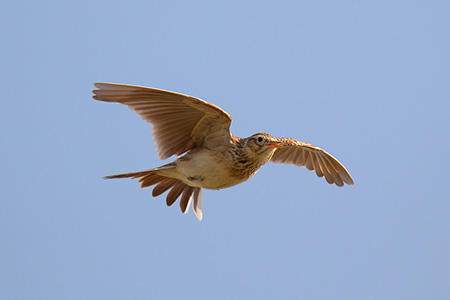
(© John / CC BY-NC-ND 2.0)
The Skylark's song is, though, enough to brighten even the dullest day, a loud, unbroken flow of clear warbling notes that is particularly far-carrying over the wide open spaces that the skylark inhabits. Song is sometimes delivered from the ground or from a perch but is more usually given in fluttering display flight as the bird gains altitude, maintains its position high in the sky for minutes on end - sometimes no more than a speck way above, at other times virtually invisible to the naked eye - and finally, still singing descends back to earth.
Particularly fitting is the collective noun used to describe a group of Skylarks: an Exultation of larks - exultation has been defined as 'a feeling of triumphant elation or jubilation; rejoicing' - and that certainly catches the spirit of the Skylark's song.
(3) Potential for confusion
A degree of care does, however, need to be taken by the unwary when separating Skylarks from other similar birds of open spaces.
Closely related woodlarks, for example, are also small, mainly streaky brown birds that share the Skylarks' preference for heathland. In broad terms, though, woodlarks are not quite as long as Skylarks but are a little stockier; they have shorter, relatively broader wings; a noticeably shorter tail; a less pronounced crest; and above each eye are bold, whitish stripes that meet on the nape. Woodlarks are also more inclined to perch in heathland-edge birch trees, whilst their song comprises a succession of sweet, clear notes delivered in quite slow, 3 - 5 second phrases, from a tree, the ground or whilst in circling, usually relatively low level, display flight
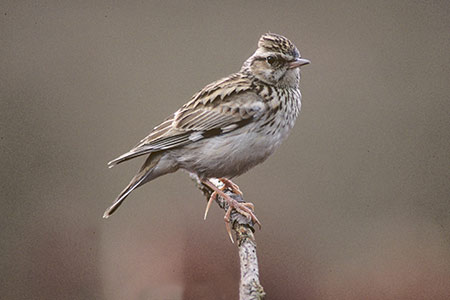
Meadow pipits and tree pipits are also superficially similar to Skylarks (and woodlarks). The former are widespread and common for much of the year on the New Forest heathlands and around the drier margins of the bogs and mires, whilst the latter occur in far smaller numbers and are breeding season visitors, present from April until September, primarily in areas of regenerating clear-fell and on heathland / woodland edges. Again in very broad terms, both are streaky brown birds that are a little smaller than skylarks and of more dainty appearance, neither has a crest, and both have distinctive, relatively low level 'parachute' display flights.
(4) Nesting behaviour
Skylarks always nest on the ground, usually in a shallow hollow and often in a site partly concealed in a tussock of grass or other vegetation. The nest is frequently lined with grass, leaves and stems, with finer material inside the cup. John Clare in the 19th century described it perfectly:
'Behind a clod how snug the nest,
Is in a Horse's footing fixed,
Of twitch and stubbles roughly dressed,
With roots and horsehair intermixed'.
Three to five eggs are laid, incubation lasts around 11 days and the young fledge after 18 - 20 days. Egg laying usually commences in late March or early April with up to four broods raised each year, spanning the period until August.
(5) Country names and traditions
Perhaps surprisingly for a bird that in days-gone-by was extremely common and widespread, the Skylark has attracted relatively few country names, although variations on Laverock were commonplace. A number of Skylark-related sayings have, however, been popularised, sayings such as 'to be up with the lark', 'to sing like a lark' and 'larking about'.
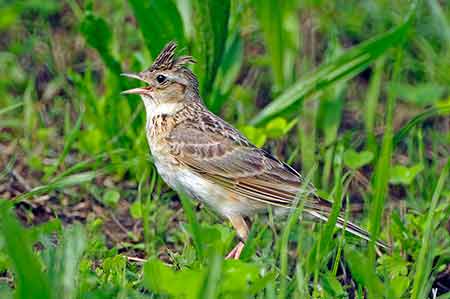
(© Ken / CC BY-NC-ND 2.0)
It was, though, the Skylark's great misfortune to be such a prolific songster, for that led the Victorians to catch many of them for sale as cagebirds; and it was even more unfortunate for Skylarks that their flesh, bones and all other body parts were considered a delicacy, leading to huge numbers being killed for the table. Thankfully, in the UK at least, such practices have long since ceased, but both continue unchecked in parts of mainland Europe and the Mediterranean islands.
(6) Breeding numbers of Skylarks in the New Forest
Numbers of Skylarks breeding on the Crown Lands have shown a steady decline between at least the late 1980s and 2012 (Hampshire Bird Atlas), maybe because, as the wider Skylark population has declined, suboptimal habitats - such as the New Forest heathlands - have been abandoned.
Recreational use of the New Forest by walkers, horse riders, dog walkers and others has also significantly increased during this period, with accompanying inevitable disturbance to wildlife; whilst vegetation changes detrimental to breeding Skylarks may have resulted from the increased grazing pressure excerted by the growing numbers of depastured commoners' animals - primarily cattle and ponies. And of course, the more cattle and ponies there are out on the open Forest, the greater the risk of ground nests being trampled and breeding birds disturbed.
(Ponies depastured on the New Forest increased from around 2,000 in 1960 to around 2,550 in 1981 (C.R. Tubbs, 1986), and reportedly had increased again to around 5,000 by 2016, an overall increase of 150%, although the trend has not necessarily been one of consecutive year-on-year increases. And then taking into account all commonable animals, in early 2020, there were reported to be 13,641 cattle, ponies and donkeys 'marked' to graze on New Forest and its commons. This was up from 8,880 animals in 2015, representing a 65% increase over only four years. So, although not all animals for which a 'marking' fee had been paid would necessarily be put out on the Forest at any one time, and debates can be had about the exact number of animals involved, the overall trend in recent years is clearly one of significantly increasing numbers).
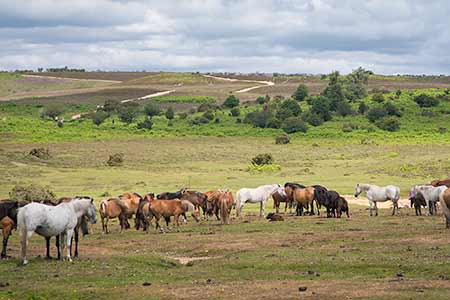
(7) The national picture
Nationally, Skylark numbers declined rapidly from the mid 1970s until the mid 1980s, when the rate of decline slowed and in recent years appears to have almost flattened out. In England, numbers declined by an estimated 63% between 1967 and 2017. (Source: BTO BirdTrends).
The declines probably occurred on farmland as a result of agricultural intensification, a switch from spring sown to autumn sown cereals, and changes to grassland management, with resultant decreases in the availability of foodstuffs and Skylark-friendly habitat. Reflecting these declines in the breeding population, the Skylark is Red listed in the UK as a bird of conservation concern.
(8) Woodlarks prosper
Yet perhaps encouragingly, not all ground nesting birds have suffered population declines. The results from a 2019 Woodlark survey by Hampshire Ornithological Society volunteers, for example, suggest that woodlark numbers in the New Forest are at least stable and may even be increasing. Woodlarks do, however, prefer a closely cropped sward for feeding - they can sometimes be seen searching for food on close-cropped roadside verges, for example - and are generally more tolerant of / attracted to relatively bare ground temporarily created following heathland burning, so increasing numbers of commoners' animals may actually increase the area and quality of habitat suitable for woodlarks.
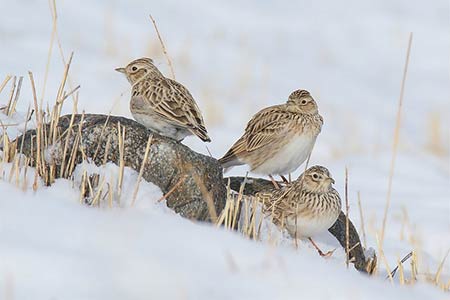
(© Imran Shah / CC BY-NC-ND 2.0)
(9) Skylarks in winter
As has already been noted, Skylarks are rarely present on the Crown Lands of the New Forest in the midst of winter, whilst elsewhere in Hampshire, including along the New Forest National Park's coastal strip and on adjacent farmland, winter numbers are influenced by weather conditions, both locally and elsewhere. In some years, significant numbers of Skylarks flee harsh weather farther north and in mainland Europe, and arrive in Hampshire; whilst harsh weather in Hampshire often encourages many Skylarks to move away in search of kinder conditions elsewhere.
References:
Hampshire Bird Atlas 2007-12: edited by John Eyre
Hampshire Bird Reports: 2015-2018
Collins Bird Guide: Mullarney, Svensson, ZetterstrÖm and Grant
Handbook of the Birds of Europe, the Middle East and North Africa, The Birds of the Western Palearctic (volumes 1-9): Stanley Cramp, et al
The New Forest - A Natural History: Colin R. Tubbs
All the Birds of the Air: Francesca Greenoak
BTO BirdTrends
RSPB
Advertiser and Times
The Guardian
Quick links
More links
Search this site

